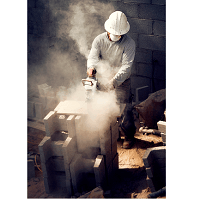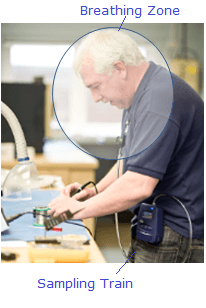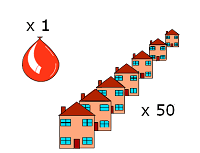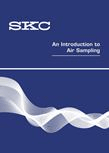- Air Sampling Pumps
- Calibration Equipment
- Servicing and Calibration
- Sampling Heads
- Sorbent Tubes
- Passive Samplers
- Particulate Monitors
- Filters and Cassettes
- Gas Sample Bags
- Air Sampling Kits
- Gastec Detection Tubes
- Face Level Sampling
- Surface & Skin Sampling
- Asbestos Sampling
- Bioaerosol Sampling
- Environmental Sampling
- Heat Stress Monitor
- Noise Monitoring
- Vibration Monitoring
What is Air Sampling and Why It is Necessary
An Introduction to Air Sampling
Health and Safety in the workplace involves a wide range of potential hazards
Airborne hazards from gases, vapours, dusts and fibres can all cause potentially life threatening illnesses affecting the lungs, kidneys and liver.

Air sampling is a vital method of monitoring workers' exposure to these potential airborne workplace hazards.
Air sampling is relevant to almost every industry, from flour dust exposure in a bakery to chemical vapour exposure in a factory.
Every year in the UK, around 13,000 people die from diseases which were caused by the work that they do, or used to do. By comparison, in 2017/2018 only 144 workers were killed at work due to fatal injuries (source: HSE).
By consistently measuring the concentration of airborne contaminants steps can be taken to reduce workers' exposure, thereby helping to prevent chronic respiratory diseases such as asthma, as well as occupational cancers.
What is Air Sampling?
Air sampling is carried out to ensure that workplace or environmental air is meeting regulatory standards and to help Occupational Hygiene and Health & Safety professionals assess employee exposure to airborne hazards.

Regulatory authorities, such as the HSE in the UK or OSHA in the USA, apply limits for exposure to most substances deemed hazardous to worker’s health.
The HSE terms these limits Workplace Exposure Limits (WELs) and they are defined as the maximum concentration of a hazardous airborne substance that a worker may be exposed to over a defined period such as an 8-hour shift.
WELs apply to anybody working within an environment where hazardous substances are present, and are based on personal sampling, not static / environmental – however, this does not mean that limits cannot apply under these circumstances.
WELs are published in the document called EH40, a guidance document which is freely available to download from the HSE’s website
Where there is a WEL there will be an approved method of sampling written by a regulatory authority such as the HSE. Where there is no specific method for a particular hazard, there are often methods for the type of contaminant - such as MDHS 14/4 for general dusts.
Types of contaminant
Control of Substances Hazardous to Health Regulations 2002 (COSHH) covers substances that are hazardous to health.
Most hazardous materials fall into three main categories: dusts and particulates, gases and vapours, or bioaerosols. A site may well have several types of contaminants.

Dusts:
- Present in almost every industry
- Risks to health from inhalation exposure, but also other hazards such as risk of explosion
- Examples include dusts from wood, flour, metals and silica
Fibres:
- Longer than they are wide
- Can be highly toxic due to size, shape and a tendency to remain in the lungs
- Examples include asbestos, ceramic fibres, or mineral fibres
Gases and Vapours:
- Vast range of potentially harmful and explosive gases and vapours across industries
- Can be harmful to the body due to toxicity leading to acute or chronic conditions
- Presence of non-toxic gases can also be dangerous due to displacement of oxygen
- Can also be harmful through skin absorption
Bioaerosols:
- Can be present in many environments, including waste management, recycling facilities and composting sites
- Could be infectious, produce toxins, or trigger an immune response
- Examples include airborne viruses, fungal spores, bacteria and pollen
Measurements
Once measured, the contaminants are expressed as milligrams per cubic metre (mg/m3) for particulates and parts per million (ppm) for gases. For instance, the maximum workplace exposure limit for toal (inhalable) dust is 10 mg/m3 over an 8 hour period.

1 milligram per cubic metre (mg/m3) is approximately the same as one teaspoon of dust spread over the area of a football field to a height of one metre

1 part per million (ppm) is approximately the same as the contents of a party balloon compared to the volume of air inside 50 three bedroom houses
Help and Advice
If you have never carried out air sampling before, or you are unsure of the workplace exposure limits, there is a range of help available.

SKC Ltd have over 50 years of experience in the industry and offer a comprehensive range of products to serve all sampling requirements.
We offer a practical training course on the use of air sampling equipment, helping you to get the most from your sampling regime.
There is more information available on this website:
- Step by Step Guide
- Sampling Guides
- Our popular Hazard Search, which is an online database of monitoring methods for a wide range of workplace and environmental hazards, which just needs the name or part-name of the hazard, or the CAS number
Further help on-line
One of the best resources for advice on legislation and potential contaminants is the Health and Safety Executive. You can visit them online at www.hse.gov.uk where you can find guidance specific to your industry, information on COSHH, and plenty of other resources to help you assess your workplace.
Other helpful resources include:
BOHS (British Occupational Hygiene Society)
www.bohs.org
MDHS (Methods for the Determination of Hazardous Substances) publications
www.hse.gov.uk/pubns/mdhs/
NIOSH (National Institute for Occupational Safety and Health)
www.cdc.gov/niosh
OSHA (Occupational Safety and Health Administration)
www.osha.gov


